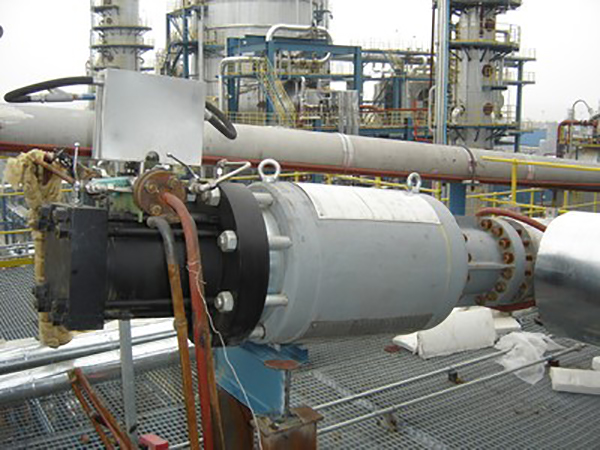Direct Coal Liquefaction

SchuF has amassed detailed process, valve and management knowhow in the field of Direct Coal Liquefaction.
Background
The process of direct coal liquefaction was developed in the 1920s in Germany. Until the mid 1950s the process was operated at several sites in Germany to derive liquid hydrocarbons from coal as a substitute to standard crude oils. In the 1980s and 1990s the Kohleoel-Anlage in Bottrop plant was operated for almost 20 years, of which the last years were in heavy oil upgrading mode.
SchuF has designed and produced Control Valves, Diverter Valves, Sampling Valves and one-off designs specifically for Direct Coal Liquefaction processes.
Angle Control Valve installed in the Shenhua coal liquefaction plant, China Photo:©SchuF
Download
Liquefaction Process
In the first step of the direct coal liquefaction process, the coal is ground and mixed with oil to yield a pumpable paste.
This paste is pumped to high pressure (200 – 300 bars) and is heated to the desired process temperature of about 450 – 460 °C.
Together with hydrogen, the coal paste is feed to the slurry reactor section, where the coal molecules are cracked and hydrogen saturates the carbon bonds of the molecules (“hydrogenation”). The main product fractions derived from the reactors are light hydrocarbons and unconverted slurry. Both fractions are separated in the high pressure hot separator. Whilst the light hydrocarbons will be further processed to high value market products, the unconverted slurry – containing high amounts of solids – is distilled under vacuum to increase the total oil yield and minimise the hydrogenation residue fraction.
The depressurisation from the high pressure hot separator to vacuum is done in several steps, of which the first let down step from high to middle pressure is the most severe step.
HPHS let down
The first separator is the high pressure hot separator (HPHS), which is situated directly behind the reactor. Pressure here is still around 200bar, temperature still over 400°C. The slurry must be let down to the HMPS (hot mid pressure separator), through a let down valve. SchuF has already introduced Multi-Stage Let Down Valves for use in hydrocrackers, but these valves are not suitable for this service because of the 3 phase nature of the media.
The high solids content prevents the use of anything other than a simple single stage let down valve.
The single seat will unfortunately cause huge cavitational effects and the high degree of flashing coupled with the solid content will completely destroy the trim and possibly the valve itself in very short time.
Angle Control valve, Photo:©SchuF
This can be minimised by the use of suitable hard metal trims, optimised trim design and a special SchuF control modus. Due to the high pressure drop these valves are usually hydraulically actuated.
SchuF has developed a valve specially for this service featuring:
Extensive use of best suited hard metal materials, such as special grain Tungsten Carbides
Optimised trim design
Proprietary control sequence
Easy-to-replace trim, allowing the valve to remain in service
HPHS Block and bleed
Even with the best design and material, this let down service is so severe that the trims have to be changed periodically. In order to ensure that this can be accomplished without plant interruption at least two let down valves are used in parallel.
This will allow one to be overhauled while the other remains in operation. This can only be achieved by isolating the control valve to be exchanged. Safety concerns mean that two zero leakage isolation valves will be required upstream of the valve, while one will normally suffice downstream. Experience from old plants show that ball or plug valves are not suitable for the upstream double block and bleed.
SchuF Design
Instead, SchuF offers a unique combination of isolation valves for this service. Thus, the first isolation valve is a Multi-port Diverter Valve. Advantage to this valve is that it closes the line to the unused Control Valve from the branch-off with absolutely no dead space. Using any other type of valve will require a T-piece with a short branch leading up to the first isolation valve. The media (coal slurry) means that this short branch will clog completely, leading to severe problems when the unused control valve has been repaired and is to be taken into service.
The Type 42VK Diverter Valve, here with 1 inlet and 4 independently, hydraulically operated outlets.
The second isolation valve is a SchuF 71KS Angle Valve. These valves are helped to seal by the line pressure, giving an extra margin of safety. The packing is protected by special internal sealing arrangements.